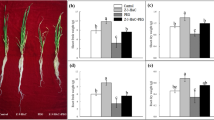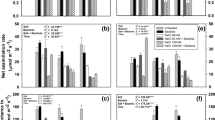Abstract
Volatile components in fresh leaves are involved in the regulation of many stress responses, such as insect damage, fungal infection and high temperature. However, the potential function of volatile components in hyperosmotic response is largely unknown. Here, we found that 7-day hyperosmotic treatment specifically led to the accumulation of (Z)-3-hexen-1-ol, (E)-2-hexenal and methyl salicylate. Transcriptome and qRT-PCR analyses suggested the activation of linolenic acid degradation and methyl salicylate processes. Importantly, exogenous (Z)-3-hexen-1-ol pretreatment dramatically enhanced the hyperosmotic stress tolerance of tea plants and decreased stomatal conductance, whereas (E)-2-hexenal and methyl salicylate pretreatments did not exhibit such a function. qRT-PCR analysis revealed that exogenous ABA induced the expressions of related enzyme genes, and (Z)-3-hexen-1-ol could up-regulate the expressions of many DREB and RD genes. Moreover, exogenous (Z)-3-hexen-1-ol tremendously induced the expressions of specific LOX and ADH genes within 24 h. Taken together, hyperosmotic stress induced (Z)-3-hexen-1-ol accumulation in tea plant via the activation of most LOX, HPL and ADH genes, while (Z)-3-hexen-1-ol could dramatically enhance the hyperosmotic stress tolerance via the decrease of stomatal conductance and MDA, accumulation of ABA and proline, activation of DREB and RD gene expressions, and probably positive feedback regulation of LOXs and ADHs.
Key message
Hyperosmotic stress induced (Z)-3-hexen-1-ol accumulation in Camellia sinensis via the up-regulation of most LOX, HPL and ADH genes, while (Z)-3-hexen-1-ol could dramatically enhance the hyperosmotic stress tolerance via the decrease of stomatal conductance, accumulation of proline, activation of DREB and RD gene expressions, and probably positive feedback regulation of LOXs and ADHs.










Similar content being viewed by others
Abbreviations
- ABA:
-
Abscisic acid
- ADH:
-
Alcohol dehydrogenase
- bp:
-
Base pair
- DEG:
-
Differentially expressed gene
- DREB:
-
Dehydration responsive element binding protein
- DW:
-
Dry weight
- GC–MS:
-
Gas chromatography-mass spectrometer
- GLV:
-
Green leaf volatile
- GO:
-
Gene ontology
- HI:
-
Hexenal isomerase
- HPL:
-
Hydroperoxide lyase
- KEGG:
-
Kyoto encyclopedia of genes and genomes
- LOX:
-
Lipoxygenase
- qRT-PCR:
-
Quantitative real-time polymerase chain reaction
References
Bate NJ, Riley JCM, Thompson JE, Rothstein SJ (2010) Quantitative and qualitative differences in C6-volatile production from the lipoxygenase pathway in an alcohol dehydrogenase mutant of Arabidopsis thaliana. Physiol Plant 104(1):97–104
Cao H, Wang L, Yue C, Hao X, Wang X, Yang Y (2015) Isolation and expression analysis of 18 CsbZIP genes implicated in abiotic stress responses in the tea plant (Camellia sinensis). Plant Physiol Biochem 97:432–442
Chen G, Hackett R, Walker D, Taylor A, Lin Z, Grierson D (2004) Identification of a specific isoform of tomato lipoxygenase (TomloxC) involved in the generation of fatty acid-derived flavor compounds. Plant Physiol 136(1):2641–2651
Copolovici L, Kännaste A, Pazouki L, Niinemets U (2012) Emissions of green leaf volatiles and terpenoids from Solanum lycopersicum are quantitatively related to the severity of cold and heat shock treatments. J Plant Physiol 169(7):664–672
Dong F, Yang Z, Baldermann S, Sato Y, Asai T, Watanabe N (2011) Herbivore-induced volatiles from tea (Camellia sinensis) plants and their involvement in intraplant communication and changes in endogenous nonvolatile metabolites. J Agric Food Chem 59(24):13131–13135
Expositoalonso M, Vasseur F, Ding W, Wang G, Burbano HA, Weigel D (2018) Genomic basis and evolutionary potential for extreme drought adaptation in Arabidopsis thaliana. Nat Ecol Evol 2:352–358
Fang W, Zhang Y, Zhou L, Wang W, Li X (2013) Isolation and characterization of Histone1 gene and its promoter from tea plant (Camellia sinensis). Mol Biol Rep 40(5):3641–3648
Galvez DA, Landhäusser SM, Tyree MT (2011) Root carbon reserve dynamics in aspen seedlings: does simulated drought induce reserve limitation? Tree Physiol 31(3):250–257
Godard KA, White R, Bohlmann J (2008) Monoterpene-induced molecular responses in Arabidopsis thaliana. Phytochemistry 69(9):1838–1849
Halitschke R, Ziegler J, Keinänen M, Baldwin IT (2010) Silencing of hydroperoxide lyase and allene oxide synthase reveals substrate and defense signaling crosstalk in Nicotiana attenuata. Plant J 40(1):35–46
Hatanaka A, Kajiwara T, Sekiya J (2017) Biosynthetic pathway for C 6-aldehydes formation from linolenic acid in green leaves. Chem Phys Lipid 44:341–361
Howe GA, Lee GI, Li L, Derocher AE (2000) Cytochrome P450-dependent metabolism of oxylipins in tomato. Cloning and expression of allene oxide synthase and fatty acid hydroperoxide lyase. Plant Physiol 123(2):711–724
Iyer S, Caplan A (1998) Products of proline catabolism can induce osmotically regulated genes in rice. Plant Physiol 116(1):203–211
Jing T, Zhang N, Gao T, Zhao M, Jin J, Chen Y et al (2018) Glucosylation of (Z)-3-hexenol informs intraspecies interactions in plants: a case study in Camellia sinensis. Plant Cell Environ 42(4):1352–1367
Joshi R, Gulati A (2011) Biochemical attributes of tea flowers ( Camellia sinensis ) at different developmental stages in the Kangra region of India. Sci Hortic 130(1):266–274
Kim JS, Mizoi J, Yoshida T, Fujita Y, Nakajima J, Ohori T et al (2011) An ABRE promoter sequence is involved in osmotic stress-responsive expression of the DREB2A gene, which encodes a transcription factor regulating drought-inducible genes in Arabidopsis. Plant Cell Physiol 52(12):2136–2146
Kim JS, Mizoi J, Kidokoro S, Maruyama K, Nakajima J, Nakashima K et al (2012) Arabidopsis GROWTH-REGULATING FACTOR7 functions as a transcriptional repressor of abscisic acid–and osmotic stress–responsive genes, including DREB2A. Plant Cell 24(8):3393–3405
Kishimoto K, Matsui K, Ozawa R, Takabayashi J (2005) Volatile C6-aldehydes and Allo-ocimene activate defense genes and induce resistance against Botrytis cinerea in Arabidopsis thaliana. Plant Cell Physiol 46(7):1093–1102
Kishimoto K, Matsui K, Ozawa R, Takabayashi J (2006) Components of C6-aldehyde-induced resistance in Arabidopsis thaliana against a necrotrophic fungal pathogen, Botrytis cinerea. Plant Sci 170(4):715–723
Kunishima M, Yamauchi Y, Mizutani M, Kuse M, Takikawa H, Sugimoto Y (2016) Identification of (Z)-3:(E)-2-hexenal isomerases essential to the production of the leaf aldehyde in plants. J Biol Chem 291(27):14023
Li XW, Feng ZG, Yang HM, Zhu XP (2010) A novel cold-regulated gene from Camellia sinensis, CsCOR1, enhances salt- and dehydration-tolerance in tobacco. Biochem Biophys Res Commun 394(2):354–359
Li Y, Huang J, Song X, Zhang Z, Jiang Y, Zhu Y et al (2017) An RNA-Seq transcriptome analysis revealing novel insights into aluminum tolerance and accumulation in tea plant. Planta 246(1):91–103
Liu SC, Yao MZ, Ma CL, Jin JQ, Ma JQ, Li CF et al (2015) Physiological changes and differential gene expression of tea plant under dehydration and rehydration conditions. Sci Hortic 184:129–141
Liu SC, Xu YX, Ma JQ, Wang WW, Chen W, Huang DJ et al (2016) Small RNA and degradome profiling reveals important roles for MicroRNAs and their targets in tea plant response to drought stress. Physiol Plant 158(4):435–451
Loreto F, Barta C, Brilli F, Nogues I (2010) On the induction of volatile organic compound emissions by plants as consequence of wounding or fluctuations of light and temperature. Plant Cell Environ 29(9):1820–1828
Mano J, Torii Y, Hayashi S, Takimoto K, Matsui K, Nakamura K et al (2002) The NADPH: quinone oxidoreductase P1-ζ-crystallin in Arabidopsis catalyzes the α, β-hydrogenation of 2-alkenals: detoxication of the lipid peroxide-derived reactive aldehydes. Plant Cell Physiol 43(12):1445–1455
Pichersky E, Gershenzon J (2002) The formation and function of plant volatiles: perfumes for pollinator attraction and defense. Curr Opin Plant Biol 5(3):237–243
Piesik D, Pańka D, Delaney KJ, Skoczek A, Lamparski R, Weaver DK (2011) Cereal crop volatile organic compound induction after mechanical injury, beetle herbivory (Oulema spp.), or fungal infection (Fusarium spp.). J Plant Physiol 168(9):878–886
Qin F, Sakuma Y, Tran L-SP, Maruyama K, Kidokoro S, Fujita Y et al (2008) Arabidopsis DREB2A-interacting proteins function as RING E3 ligases and negatively regulate plant drought stress–responsive gene expression. Plant Cell 20(6):1693–1707
Sanderson GW, Grahamm HN (1973) Formation of black tea aroma. J Agric Food Chem 21(4):576–585
Sharma P, Kumar S (2005) Differential display-mediated identification of three drought-responsive expressed sequence tags in tea [Camellia sinensis (L.) O. Kuntze]. J Biosci 30(2):231–235
Shyp V, Tankov S, Ermakov A, Kudrin P, English BP, Ehrenberg M et al (2012) Positive allosteric feedback regulation of the stringent response enzyme RelA by its product. EMBO Rep 13(9):835–839
Upadhyaya H, Panda SK (2004) Responses of Camellia sinensis to drought and rehydration. Biol Plant 48(4):597–600
Upadhyaya H, Panda SK, Dutta BK (2008) Variation of physiological and antioxidative responses in tea cultivars subjected to elevated water stress followed by rehydration recovery. Acta Physiol Plant 30(4):457–468
Wang L, Lin Z, Hai-Peng L, Tan JF, Guo L (2010) Research progress in affecting factors of tea aroma. Food Sci 31(15):293–298
Wang W, Wang Y, Du Y, Zhao Z, Zhu X, Jiang X et al (2014) Overexpression of Camellia sinensis H1 histone gene confers abiotic stress tolerance in transgenic tobacco. Plant Cell Rep 33(11):1829–1841
Wang P, Zhao L, Hou H, Zhang H, Huang Y, Wang Y et al (2015) Epigenetic changes are associated with programmed cell death induced by heat stress in seedling leaves of Zea mays. Plant Cell Physiol 56(5):965–976
Wang YX, Liu ZW, Wu ZJ, Li H, Zhuang J (2016a) Transcriptome-wide identification and expression analysis of the NAC gene family in tea plant [Camellia sinensis (L.) O. Kuntze]. PLoS ONE 11(11):e0166727
Wang Y, Shu Z, Wang W, Jiang X, Li D, Pan J et al (2016b) CsWRKY2, a novel WRKY gene from Camellia sinensis, is involved in cold and drought stress responses. Biol Plant 60(3):1–9
Wenda-Piesik A (2011) Volatile organic compound emissions by winter wheat plants (Triticum aestivum L.) under Fusarium spp. infestation and various abiotic conditions. Pol J Environ Stud 20:1335–1342
Xu YX, Mao J, Chen W, Qian TT, Liu SC, Hao WJ et al (2016) Identification and expression profiling of the auxin response factors (ARFs) in the tea plant (Camellia sinensis (L.) O. Kuntze) under various abiotic stresses. Plant Physiol Biochem 98:46–56
Yamauchi Y, Kunishima M, Mizutani M, Sugimoto Y (2015) Reactive short-chain leaf volatiles act as powerful inducers of abiotic stress-related gene expression. Sci Rep 5:8030
Yang Z, Kobayashi E, Katsuno T, Asanuma T, Fujimori T, Ishikawa T et al (2012) Characterisation of volatile and non-volatile metabolites in etiolated leaves of tea (Camellia sinensis) plants in the dark. Food Chem 135(4):2268–2276
Yoshida T, Mogami J, Yamaguchi-Shinozaki K (2014) ABA-dependent and ABA-independent signaling in response to osmotic stress in plants. Curr Opin Plant Biol 21:133–139
Zhang S, Yue Y, Sheng L, Wu Y, Fan G, Li A et al (2013) PASmiR: a literature-curated database for miRNA molecular regulation in plant response to abiotic stress. BMC Plant Biol 13(1):33
Zhang Q, Cai M, Yu X, Wang L, Guo C, Ming R et al (2017) Transcriptome dynamics of Camellia sinensis in response to continuous salinity and drought stress. Tree Genet Genomes 13(4):78
Zhao L, Wang P, Hou H, Zhang H, Wang Y, Yan S et al (2014) Transcriptional regulation of cell cycle genes in response to abiotic stresses correlates with dynamic changes in histone modifications in maize. PLoS ONE 9:e106070
Zhou L, Xu H, Mischke S, Meinhardt LW, Zhang D, Zhu X et al (2014) Exogenous abscisic acid significantly affects proteome in tea plant (Camellia sinensis) exposed to drought stress. Hortic Res 1:14029
Funding
This work was supported by the National Key R&D Program of China (2018YFD1000601) and Fundamental Research Funds for the Central Universities (2662016QD024).
Author information
Authors and Affiliations
Contributions
SH and PW designed the experiments. SH and QC performed the experiments. SH and PW wrote the manuscript. FG, MW, HZ, YW and DN revised the manuscript.
Corresponding author
Ethics declarations
Conflict of interest
The authors have no conflicts of interest to declare.
Additional information
Publisher's Note
Springer Nature remains neutral with regard to jurisdictional claims in published maps and institutional affiliations.
Accession numbers
The data sets of raw sequencing reads have been deposited in the National Center for Biotechnology Information (NCBI) database and can be retrieved under the BioProject Accession Number PRJNA513275.
Electronic supplementary material
Below is the link to the electronic supplementary material.
Rights and permissions
About this article
Cite this article
Hu, S., Chen, Q., Guo, F. et al. (Z)-3-Hexen-1-ol accumulation enhances hyperosmotic stress tolerance in Camellia sinensis. Plant Mol Biol 103, 287–302 (2020). https://doi.org/10.1007/s11103-020-00992-2
Received:
Accepted:
Published:
Issue Date:
DOI: https://doi.org/10.1007/s11103-020-00992-2




